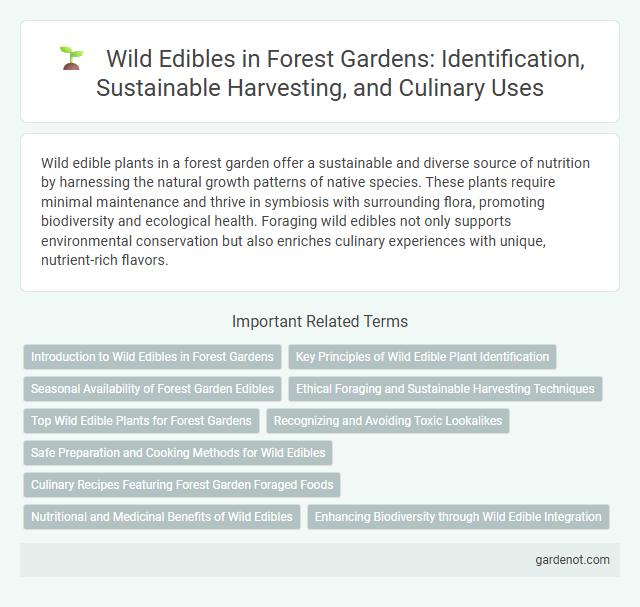Wild edible plants in a forest garden offer a sustainable and diverse source of nutrition by harnessing the natural growth patterns of native species. These plants require minimal maintenance and thrive in symbiosis with surrounding flora, promoting biodiversity and ecological health. Foraging wild edibles not only supports environmental conservation but also enriches culinary experiences with unique, nutrient-rich flavors.
Introduction to Wild Edibles in Forest Gardens
Wild edibles in forest gardens consist of naturally occurring plants that provide nutritious and sustainable food sources, such as wild berries, nuts, and leafy greens. These plants contribute to biodiversity, support local ecosystems, and require minimal maintenance compared to traditional crops. Incorporating wild edibles enhances food security while promoting ecological balance within the forest garden system.
Key Principles of Wild Edible Plant Identification
Accurate wild edible plant identification relies on key principles such as recognizing leaf shape, flower structure, and growth patterns unique to each species. Understanding habitat preferences and seasonal timing enhances the ability to distinguish safe, nutritious plants from toxic look-alikes. Utilizing reliable field guides or expert knowledge ensures sustainable foraging within forest garden ecosystems.
Seasonal Availability of Forest Garden Edibles
Forest gardens offer a diverse array of wild edibles that vary seasonally, with spring bringing tender greens like wild garlic and nettles, while summer yields berries such as blackberries and raspberries. Autumn provides an abundance of nuts, mushrooms, and late-season fruits like hawthorn and crabapple. Understanding the seasonal availability of these forest garden edibles ensures sustainable harvesting and maximizes foraging success throughout the year.
Ethical Foraging and Sustainable Harvesting Techniques
Wild edible plants in forest gardens require ethical foraging practices to ensure ecosystem balance and long-term availability. Practicing sustainable harvesting techniques, such as selective picking and avoiding overharvesting, preserves plant populations and habitat health. Knowledge of local regulations and seasonal growth patterns enhances responsible foraging and supports biodiversity conservation.
Top Wild Edible Plants for Forest Gardens
Top wild edible plants for forest gardens include purslane, lamb's quarters, and wild garlic, valued for their nutritional density and low maintenance. These perennials thrive in diverse conditions, providing a continuous harvest of vitamins, minerals, and antioxidants essential for a sustainable diet. Incorporating such plants enhances biodiversity, soil health, and food security within forest garden ecosystems.
Recognizing and Avoiding Toxic Lookalikes
Identifying wild edible plants requires careful observation to distinguish them from toxic lookalikes that can cause severe poisoning or allergic reactions. Key characteristics such as leaf shape, growth patterns, and berry color are essential for safe foraging in forest gardens. Learning from reputable field guides and local experts minimizes risks and ensures responsible harvesting of nutritious wild foods.
Safe Preparation and Cooking Methods for Wild Edibles
Safe preparation and cooking methods for wild edibles include thorough washing and proper heat treatment to eliminate parasites, bacteria, and toxins. Identifying edible species accurately and avoiding those known to contain harmful compounds such as oxalates or alkaloids is crucial for safety. Cooking techniques like boiling, steaming, or roasting often reduce toxicity and enhance nutrient availability in wild plants harvested from forest gardens.
Culinary Recipes Featuring Forest Garden Foraged Foods
Wild edible plants harvested from forest gardens, such as ramps, fiddleheads, and wild garlic, add unique flavors and nutritional value to culinary recipes. Incorporating these foraged foods into dishes like wild greens pesto, fiddlehead frittatas, and ramp-infused soups enhances the taste profile while promoting sustainable, seasonal eating. Utilizing forest garden ingredients supports biodiversity and connects chefs with natural, nutrient-dense food sources for creative, health-conscious cooking.
Nutritional and Medicinal Benefits of Wild Edibles
Wild edibles in forest gardens provide a rich source of vitamins, minerals, and antioxidants essential for boosting immune function and overall health. Many species, such as wild garlic and dandelion, exhibit significant medicinal properties, including anti-inflammatory and detoxifying effects. Incorporating these nutrient-dense plants into diets supports natural healing and promotes sustainable foraging practices.
Enhancing Biodiversity through Wild Edible Integration
Integrating wild edible plants into forest gardens significantly enhances biodiversity by providing diverse habitats and food sources for pollinators, birds, and beneficial insects. Species such as wild garlic, elderberry, and nettles contribute to nutrient cycling and soil health while supporting native wildlife populations. This approach fosters resilient ecosystems, promotes genetic variety, and sustains ecological balance within sustainable agroforestry practices.
Wild edible Infographic

 gardenot.com
gardenot.com